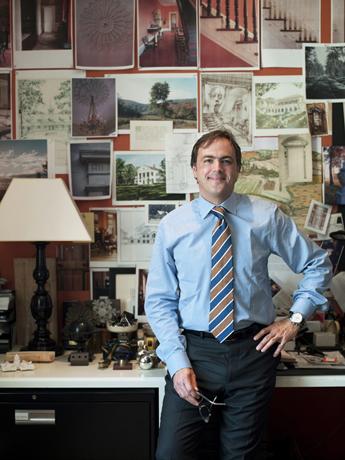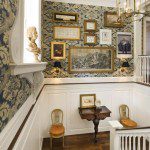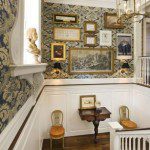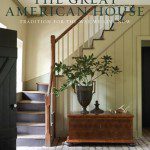The Beauty is in the Details, The Architecture of Gil Schafer
By • June 18, 2013 0 3111

“We live differently today in terms of lifestyle, what people do, family arrangements, than in the past.”
We were talking with the highly in-demand architect Gil Schafer III about “The Great American House,” his Rizzoli published book, subtitled “Tradition for the Way We Live Now.” It is sumptuously beau¬tiful, demonstrating his philosophy and penchant for creating, restoring and building homes and structures right on the spot where history walks through the door, hand in hand with the contem¬porary and with an eye toward the future.
He was driving toward upstate New York at the time, and the tone was conversational and philosophical. From a man who has collected numerous awards and attention for his work after over 20 years as an architect, his journey to suc¬cess seemed almost pre-determined, if only for the fact that he comes from three generations of architects, plus “my parents (who were not archi¬tects) were always building stuff, making things. so I can say I came by my lot naturally.”
But there was more to it than that: the book and the vocation comes from living in numer¬ous places in different parts of the country. “My grandmother had a dark old house in Cleveland, where my brother and I spent time that I still cher¬ish,” he says. “I lived on a farm upstate New York in the Hudson River Valley and also spent a time in California by the beach.”
You can find much of this reflected in the kinds of projects his firm takes on from small things like stables or sheds, to large houses in the country or renovated apartments in Greenwich Village, to island homes. You can see all of this too, and especially in the dramatic, revealing photographs in the book, which give you a seri¬ous case of the wants and desires. While devoid of people, it seems full of a kind of dossier about people, information about the emotional and his¬torical environment in which people want to live.
When he talks, or if you read about his lec¬tures or the commentary and essays in the book, or the content of interviews in major like magazines like “Veranda,” “Town and Country” or “Manner of Man,” as well as the Architectural Digest or the New York Times, some common themes can be found. They arch around the ideas that arise from the tensions that exist naturally (in art as well as in architecture) between tradition and the modern, the historical and the contemporary. Not surprisingly, he has a reputation for being a stylish dresser. Details, those lying in the framework of the big ideas, matter.
He handles the language of architecture and expands it by mixing it with the familiar you’ll find lots of common usage architectural terms in the text and commentary of the book. But the writ¬ing maintains a conversational tone, inviting the reader in much the same way that he talks about such things. For the uninitiated or inexpert, this makes his work and ideas accessible not only to his clients but also to the casual visitor.
“You have to think about how people live today,” he says. “We live differently today in terms of lifestyle, what people do, family arrange¬ments, than in the past. When you’re renovating a large house, for instance, you can see certain spaces the small kitchens, the spaces where the butlers and servants worked, that kind of thing, which are either larger today, or don’t even exist anymore. We live differently today, but we can’t dismiss the attraction and endur¬ance of the past.”
Put another way, what we try to, he said and it’s also one of the themes of the book is to “retain the well-loved proportions, details and character of a traditional house while balancing holistically with the needs of our twenty-first century lifestyle.” He also writes about the “interior architecture and the fabrics, furniture and wall treatments, and how “the landscape surrounding the home must relate to its overall design”
“The Great American House” is Schafer’s first book, although in terms of the writing (with Mark Kristal) it doesn’t feel that way. It is about architecture, by a noted architect, to be sure, but it never seems so technical as to escape the boundaries, energy, and rhythms of daily life. This is perhaps the point.
The book is structured around three ideas and themes, with four projects and homes serving as dramatic, astonishingly beautiful profiles and illustrations of the themes. In the book, the cornerstones of a great traditional house are architecture, landscape and decoration.
One of the profiles includes Schafer’s home in the Hudson Valley, a bucolic, artistically historic setting, as well as the process involved in the design of a “new” farming estate for a young family, the renovation of a historic home in Nashville, originally designed by Charles Platt, and the restoration of an 1843 mansion in Charleston, South Carolina.
Home is where the heart is, but also where the heart was it’s about bringing the past forward, letting it breathe in the here and now, renewing itself in new atmospheres.
When he talks about his grandmother’s house, he talks in some detail how it felt at night, the land, the light, the way he could travel easily around the house as a boy and the dramatic fact that the house was pink. “It was pink,” he said. “It stood out. It had that vivid color. It was a wonderful thing to see.”
In the book, the writer remembers more. “At Melrose, there were all sorts of charm at work. The old horseshoe over the front door placed there for luck, an intriguing doorknob with the face of a man on it, a beat-up bronze bucket, overflowing with cut branches, an old leather satchel with the name Melrose on it filled daily with mail.”
These memories are inspirations for Schafer, because, as he says, “They inspired me to enter the family trade, so to speak.”
But they also find their way into the proj¬ects of his firms, his collaborations, his focus on how his clients live, what they want, and their taste in objects. The motto of his firm, G.P. Schafer Architect, PLLC, is “Creating places that enhance the enjoyment of life.” That’s probably an oversimplification, because the beauty is in the details.
In the book, you can find the details in Schafer’s accessible essays and writing style, as well as in the photographs. Schafer loves not just furniture, but furnishings, those extra details that are tactile in nature: the color of burnished wood, brass knobs, light and lamps. It’s all there in a full-page photograph of the doors on his Greewich Village apartment, fea¬turing brass rim locks with cobalt glass knobs and traditional wood graining. This description doesn’t encompass the feeling that this photo¬graph like almost all of the photographs in the book give off. That sun-baked deep brown stain of the door, the key in the look, the gold of the latches. The frame is a portrait not just of something but of someone.
There are some things you might remem¬ber from the photographs, even though you have never seen them. You remember rooms opening to the sun, thin chairs with decorated cushions, ceiling fans, staircases that make you a little dizzy with their elegance, a Greek bust in a bathroom, plush easy chairs, flowers, a ladder for a book case, gates overrun with ivy, well-worn but orderly books. With Schafer’s designs, you never feel as though you are step¬ping into a museum. You can sense that people live here, come up the driveway through the gate, stride through the rooms, open an elon¬gated, white-framed window and look out at an American landscape.
It is thus natural that Schafer should be who he is: his whole life revolves around his design, his collaborations, his office, the apartment, the Hudson home, the current and ongoing proj¬ects. He is one of those people blessed by doing what he loves. “It’s funny,” he says. “This is not just my work. It’s what I do, period. It’s all the travel, the buying, the scouting, the antiquing, of course, but the end results are the homes, and the best thing is working with the clients.”
When you listen to Schafer who studied at Haverford and Bryn Mawr Colleges and has a master’s degree in architecture from Yale, where he received the H.I. Feldman Prize, you realize he is talking about his own memories, homes he’s lived in and been a part of. They are at his fingertips, and the ideas make them tingle. He is a good memory keeper for himself and others. As he writes, “If a house is going to feel like a home, it has to create opportunities for memories, even in the small¬est moments of life.”
- Jordan Wright
- Jordan Wright











